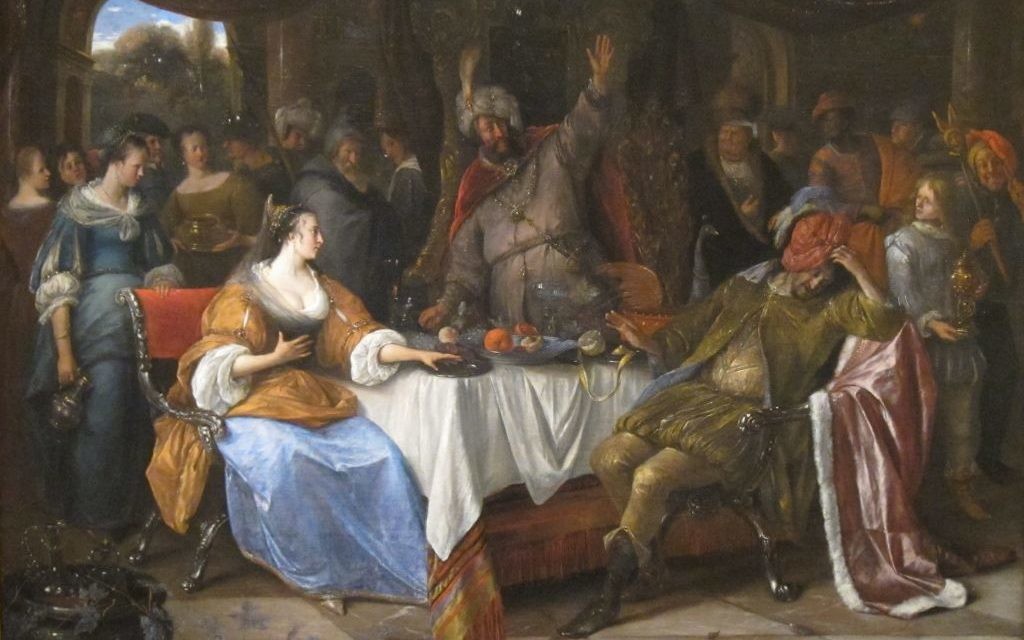Joy When the World Turns Topsy-Turvy
Judaism gives us tools to find happiness amid uncertainty and fear, as we do during Purim.
My friend Dr. Pamela Lyss, a psychiatrist, always reminds me that the hardest thing is living with uncertainty. However, we are rarely afforded certainty. How, then, do we navigate when things are uncertain or, worse yet, feel topsy-turvy?
One answer, according to Jewish tradition: Be happy.
I will forever be haunted by the nostalgia for the Purim celebrations of my childhood, in which we filled red wagons and the backs of station wagons with plates of food, dressed in costumes, and delivered and received gifts from others in the Jewish community. In synagogue, we used to tie the men’s tallisim to the banister of the bimah. There were large feasts and endless sweets. It was such a happy holiday.
Get The AJT Newsletter by email and never miss our top stories Free Sign Up
The laws and customs of Purim mandate happiness.
All this happiness is profoundly connected with the deep uncertainty that is just as fundamental to Purim.
The biblical story of Esther is filled with violence and fear. Jews and women are at the mercy of those with power.
Women’s lives are lived and lost at the mercy of their willingness to give their bodies in service to the king. Victory against Haman is achieved, but the decree against the Jews is not fully revoked, just mitigated so that the Jews are allowed to defend themselves.
What must it have felt like for Jews to sit and wait to be attacked?
Esther used her beauty to persuade the king to come to the aid of her people this time, but she must have wondered what would happen when she lost her looks. After all, she must have known the fate of Vashti, who dared to defy the king.
Even the traditional prescription to imbibe alcohol until we don’t know the difference between Mordechai and Haman points to the fragility of not knowing where things stand and the potential for reality to change at any moment, with no clear distinction between good and evil.
How can we be happy when we are uncertain? When we are scared?
Our tradition gives us tools. The custom of giving gifts of food reminds us to connect with others and strengthen community. Community grounds us and gives us hope and strength — a reminder that we are not alone.
The tradition of giving to the poor reinforces our sense of responsibility to others and takes us out of the narrow confines of our own experience and concerns. And while self-care through eating and drinking can get out of hand if done without intention, a good meal and a glass of wine shared with others can settle us.
Purim as an adult will never be the pure joy and wonder it was for me as a child. I hold too much understanding of the complexities that lie behind the happy customs. I am not so foolish as to believe that the heaviness of uncertainty, the real fears we face, can be solved with mandated happiness. It cannot.
But the types of happiness set by the rituals of Purim can in some cases provide us with hope and possibly help us make a plan of action. Joy is rarely top of the list when we think of tools for change, but it can be.
Happiness can allow us to be in the moment and appreciate the joys that sometimes get lost when worry is all-consuming. Happiness has the potential to shift our vision of what we might think is fixed and immutable. And when our vision shifts, sometimes we can see new options and potential.
Joy does not negate the uncertainty. As Muslim thinker Amanda Quraishi explains, “The world will ALWAYS be full of danger, and there will always be uncertainty that clouds our future. … But still, we must find a way to joy. That doesn’t mean burying our heads in the sand, or swimming in delusion. It means that we must do two things at once: We must celebrate life WHILE we soberly assess risk and mitigate damage.”
My friend Pam is right: We crave certainty. It is a craving that is most intense when it is out of our reach, when the terrain is topsy-turvy. But we can do our best to thoughtfully and deliberately embrace joy as one of the ways to steady our footing so that we can move forward.





comments